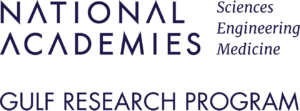Annually, the U.S. Gulf Coast is subjected to the ever-increasing threat of hurricanes, characterized by high winds, heavy rainfall, and storm surges. These weather events not only jeopardize the safety and well-being of coastal regions but also have the potential to trigger toxic petrochemical spills — with contents ranging from petroleum products to crude oil — from aboveground storage tanks (ASTs) associated with the region’s oil and gas sector. Little is known about the specifics of tank contents or how far their spills can reach, and with over 8,000 in the Houston Ship Channel Region alone, they pose a serious threat to human health.
With funding from the Gulf Research Program of the National Academies of Sciences, Engineering, and Medicine and guided by previous research from affiliated institutions, the following study aims to develop a modeling framework capable of assessing and describing the true health risk faced by overburdened communities due to these storm-related spills that takes into consideration the structure and shortcomings of ASTs, weather and environment dynamics, the health of overburdened, under-resourced Gulf Coast communities, and the future threat of climate change. We aim to assess, describe, and communicate the risks that this convergence of hazards poses to the Gulf Coast, focusing specifically on the Houston Ship Channel in Texas and the Industrial Corridor of Baton Rouge, Louisiana. The project will be collaboratively conducted by a team of individuals across several institutions, including Mississippi State University (Prime), Rice University, and Columbia University over the course of 3 years.
In collaboration with Mississippi State University, Rice University, Lamont Doherty Earth Observatory, and the National Center for Disaster Preparedness, the following research objectives were established:
Study Objectives
Characterize tropical cyclone hazards under current and future climate scenarios
Evaluate the structural vulnerability and potential tropical cyclone-induced spill volumes from aboveground storage tanks
Estimate the extent of pollutant plumes and affected neighborhoods
Investigate the current and future health impacts in affected Gulf Coast communities, specifically the Houston Ship Channel and Baton Rouge
Communicate related public health risks to the broader public, stakeholders, and community members
Methodology
Tasks 1 and 2 explore how hurricane behavior interacts with ASTs to contribute to chemical release into the environment. The Health Impact Assessment, Task 3, will be led by the National Center for Disaster Preparedness. Using multiple data inputs, which include community focus groups and key informant interviews coupled with quantitative modeling data, we will investigate how future climate will impact local public health. In Task 4, after these data-driven tasks, an interactive website will be created to provide visualizations of the health outcomes explored in this project which may vary on future climate, hurricane intensity, and current AST fragility estimates. All data will be made publicly available through the Gulf Research Project’s partnership with the Gulf of Mexico Research Initiative Information and Data Cooperative (GRIIDC). We hope our findings will provide communities with data to support policy and advocacy initiatives to promote environmental justice, with our overarching goal being to improve the health and climate change resilience of Gulf Coast communities.

Project Team:
Faculty and Staff
- Boniface Fosu Lead PI, Northern Gulf Institute, Mississippi State University
- Jamie Padgett PI, Department of Civil and Environmental Engineering, Rice University
- Mona Hemmati PI, Lamont-Doherty Earth Observatory, Columbia University
- Jonathan Sury co-PI, National Center for Disaster Preparedness, Columbia University
- Chia-Ying Lee co-PI, Lamont-Doherty Earth Observatory, Columbia University
- Adam Sobel co-PI, Department of Applied Mathematics and Earth and Environmental Sciences, Columbia University
- Suzana Camargo co-PI, Lamont-Doherty Earth Observatory, Columbia University
- Kyle Mandli co-PI, Flatiron Institute – Simons Foundation
Graduate Students
- Jainish Patel, Rice University
- Kendall Capshaw, Rice University
- Henry Lin, Mississippi State University
- George Johnson, Columbia University

This project is funded through a grant from the National Academies of Sciences Engineering and Medicine Gulf Research Program (GRP). Press Release: https://bit.ly/4aRTC6m

